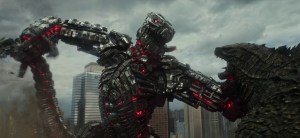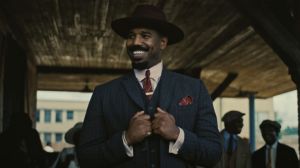
We at ComicBook.Com were very, very big fans of The Superior Foes of Spider-Man at Marvel Comics. It was a comic unlike anything else from the publisher, filled with laughs and a surprisingly compelling cast of ne’er-do-wells. Right as Superior Foes concluded, series artist Steve Lieber and writer Nick Spencer announced their next collaboration coming from Image Comics: The Fix.
Videos by ComicBook.com
Now The Fix is almost in and ComicBook.Com contributor Chase Magnett has had an opportunity to check out the first issue. It’s a hilarious romp combining elements of crime and comedy genres into a farce unlike anything else in comics today. Magnett was able to sit down with series artist and Joe Kubert School graduate Steve Lieber to discuss the process of creating the book and how he makes comics this funny and compelling.
How did you initially hear about The Fix? Did Nick [Spencer] pitch it to you or did you develop it together from the start?
Lieber: Nick pitched it to me. After we finished Superior Foes of Spider-Man, we talked a bit. We knew we wanted to work together; it was clearly a great creative partnership. Working with him was like working with no one else I had ever collaborated with and we knew we wanted to continue this thing. There was still plenty of magic left.
He had three ideas he had been tossing around and they were all terrific ideas. Any of them could be entertaining series, but one of them struck me as being particularly in my wheelhouse and that was developed into The Fix.
You guys announced The Fix right after Superior Foes ended with that small “The Fix Is In” teaser. I know sometimes writers and artists will almost interact purely through editors at Marvel, but that clearly wasn’t the case here. What was your experience like working on Superior Foes that made this partnership click?
Lieber: I call it “flourishing under benign neglect”. The Marvel editorial schedules are so unreasonable for what they put their middle management through. The guys who actually edit the books are given an impossible workload, which means they really have to trust a writer and artist to do the job well without a lot of input or interference because there just isn’t time to do heavy editing in all the books. I imagine they reserve their real editorial time for the books with the most important characters – the ones that are going to be in movies soon and the ones they have big plans for – which for a book like Superior Foes of Spider-Man meant we could be cheerfully ignored. It was easy to tell from the very, very start that we could get away with things because these characters didn’t need to be protected.
Nick’s script in places was traditional, in places he was writing Marvel style or giving me strings of dialogue to break down as I will. He did just a little of that at first, but as he saw that he could trust me with less input, he would give me more freedom to improvise or experiment. That’s a great gift for an artist. I took the ball and ran with it. There were a lot of great possibilities in there. What he gave me was funny and I found opportunities to find the funny in the gaps between panels and in places where I could take a scene off road and do something strange with it. At the beginning it started off as an amusing crime book and we found ourselves steering into the farce very quickly because there’s so much potential there.
You and Nick seem to share a collaboration where you amplify one another’s work and bring out the best in one another. You find ways to take given material or suggestions and create or improve upon what’s there. What is your process like when you first receive a script from Nick and prepare to turn it into a comic?
Lieber: Usually I get 2 to 3 pages of script at a time; Nick kind of drip feeds it. He’s got so many books that he’s doing right now. I get a scene and I just start picturing it in my head. Sometimes if there’s 30 dialogue exchanges in a 3 page scene, it will be me dealing with a whole lot of small panels. Other times if there’s a lot of freedom – if he’s written a Marvel style sequence or a series of beats that need to be hit upon over a few pages – I can think really hard about that and decide maybe this is a place where I’ll slow the pace down and do a couple of big pictures or maybe keep going with the really dead stuff. I try to approach it like I’m doing improve on stage. I get what I’m given and go “Yes, and?” and see what I can give to it.

You mentioned the dense dialogue scenes that are included in both Superior Foes and The Fix. The challenge of making those pages engaging and interesting may not be noticed by many readers, but it’s something that’s very difficult to do. In The Fix #1 there are pages of 10 to 12 panels all focused on Donovon telling this hilarious sex story that are really fun to read visually, even though it’s just a few guys talking. How do you approach a scene like that?
Lieber: The first thing I do is break down the script and make little notes about where the funniest moments are for panels to land. Generally with those scenes, Nick doesn’t write “Panel One, Panel Two, Panel Three”. I just have a few pages of dialogue like a script from a play and I adapt that to comics. I look for things like the best place for a page to end, if there’s a funnier or more suspenseful moment that will send the reader to flipping the page and continuing. That’s almost always the first thing I look for.
I also look for natural groupings of dialogue. Is the gag funnier if there’s a breath between two characters saying something? Or is it funnier with three balloons all in one panel? There’s no science to it whatsoever. It’s just finding the rhythm of it and trying to hear it in my head before I draw it. I always letter my thumbnails. First I’ll do a tiny, tiny, incomprehensible doodle – I’ll post these occasionally to my Twitter – and they’re things that nobody on Earth could decipher. They look like the scribbling of a lunatic. From that I’ll go to a much more detailed thumbnail digitally where I’ll actually lay in the dialogue. I’m putting it into panels and reading it that way. I spend a lot of time moving words from one panel to another thinking something like, “well, I could move that bit from there to there and make it look like Roy had to think for a second before giving that answer.” Or I could emphasize a moment of condescension or sarcasm by breaking a balloon from one unit into two.
It’s all deep dive into comics stuff that’s informed by a lifetime of reading these things obsessively. Initially I have a sense for what the rhythm of a scene is and what makes it visually interesting. Then I keep trying to find some sort of visual hook or something for a character to be doing that gives us some insight into the character or reveals another facet of their personality. I’ll decide if there’s some bit of their backstory or running gag that I want to emphasize in there. And if a panel doesn’t need to communicate anything about the main character, I’ll jump on that as a chance to sneak in some information about the larger story. There’s a whole lot of information I’m juggling and I like the technical challenge of deciding where and how to include it all.
That’s something I picked up on my second and third times reading The Fix #1, that these are sequences that are very entertaining and informative in spite of being not obviously visual narratives. It made me think of “Wally Wood’s 22 Panels That Always Work” and how a skilled cartoonist can make any sequence visually engaging.
Lieber: The funny thing about “Wally Wood’s 22 Panels That Always Work” is that it’s not a recipe for good storytelling; it’s what you do in cases where the story has no obvious visual component. It’s a “In Case of Fire, Break Glass” sort of thing. With the scripts that Nick is giving me, there’s almost always something I can do in the pictures or with the acting or in the “camerawork” to make the scene my own and make sure the pictures are carrying their burden of the storytelling. One thing the scenes almost never do is follow that terrible science fiction trope of “As you know Bob…” where one character explains something they both know but the reader doesn’t.
There is a great rat-a-tat-tat, almost like shadow boxing, to how the dialogue goes. Looking at how the pages break down, they really capture that rhythm and find the funniest moment in each individual part.
Lieber: Rhythm is almost 100% of what I’m doing with that stuff. I’m never focused on making a pretty drawing or an impressive page. That’s all stuff I haven’t emphasized in years. It’s stuff I still love doing, but designing a page to be impressive as you flip through the book would clobber what we’re doing. The panels and layouts are willfully and decisively bland, because the moment I start making impressive pictures, the punchlines are dead.
It’s almost the stylistic opposite of someone like J.H. Williams III in that its primary concern is clarity and legibility over flourish and exaggeration. It’s not a bad thing, but an example of two valid approaches on opposite ends of a spectrum.
Lieber: The model for it is Percy Crosby’s Skippy and John Stanley’s Little Lulu and Charles Schulz’s Peanuts and stuff like that. It’s putting the camera where it communicates things simply and directly. It’s never choosing an impressive shot when there’s a boring one that’ll do the trick. (laughs) It’s just trying – I lack the Hollywood jargon for this stuff – just trying to never oversell a punchline. I never want to be the kind of comedian who says something funny, then says it louder and stares at the audience waiting for them to laugh.

We’ve been talking a lot about pages where there’s a lot of talking, but I don’t want to give the impression this is a dialogue-focused book. There are a lot of great scenes in the book that go big and almost have no words on them, like a hilarious sequence featuring a criminal rampaging on bath salts or a shootout at a retirement facility. Beyond the rhythm of an individual page, The Fix has a great rhythm throughout moving between big and small scenes, between action and dialogue, between small and big. Those fluctuations keep the reading experience very engaging.
Lieber: That’s the goal and I’m glad we get to do different kinds of comedy in there too: everything from giant slapstick to subtle wordplay stuff. Douglas Wolk in a review he wrote years ago said there are very few pleasures in the world like watching a character be like themselves. Whether that’s Sherlock Holmes being willfully infuriating to piss off Watson or Leslie Knope being hyper-efficient or one of a million other examples.
We get a lot of joy from moments like that, where you think that’s clearly what he would do in that situation. You can communicate it in the pictures when the dialogue is doing the work of advancing the plot.. You can use pictures to remind readers what a terrible person this guy is. One of my favorite examples of that is in a later issue of Superior Foes where Boomerang is out enjoying the day and he casually rips off another guy’s wallet. It’s got nothing to do with the larger story or advance the plot at all, but of course he’d do that if he saw a guy bending over with his wallet sticking out.

I think that highlights something that’s really enjoyable about The Fix #1 in that it’s loaded with details. Even if you don’t notice them all, they all enhance the reading experience with a laugh or by providing some insight into who a character is, often both. It makes re-reading the book very enjoyable, like when I noticed one character in a flashback is using a poster of Walter Mondale for target practice as a child.
Lieber: I think that was one of Nick’s ideas in the script; that had to be Nick. I remember laughing when drawing it. That whole flashback just killed me.
Those details make The Fix a very rewarding comic to read. When you read someone like Kirby or Perez doing superheroes, the rewards come in the big moments that aren’t diminished upon multiple readings. But in something like this, a crime comic or humor comic, the rewards of re-reading come from the details. The laughs are good again, but you find new things to laugh at or some new level of a character.
Lieber: I know exactly what you mean. I feel like the animating details in a superhero story, the things that define and motivate a character are their virtues. In a crime story or a comedy story – and this is something they have in common – the most interesting parts of characters are their flaws:what’s wrong with them, the mistakes they make. A lot of the details we layer ino the pages are there to reinforce the ways these characters are messed up.
You’ve worked on comics with a lot of craziness to them, like Superior Foes and Quantum & Woody, but I feel like the thing you bring to comics is an eye for detail and personality in a manner influenced by classic cartoonists. We mentioned Wally Wood earlier and it’s that focus on clear, excellent storytelling that seems to be the connective thread through all of your work.
Lieber: A lot of the credit for that goes to my teachers. I was a student at the Joe Kubert school in the late 1980s and learned from guys like Joe. When comics were going into the super flashy 90s, my focus was the super clear storytelling of the 50s. I was steering towards goals and techniques that were state of the art for 1954.

It’s odd, but that may be what makes your work stand out. Both with Superior Foes at Marvel and now The Fix at Image, you and Nick are doing something unlike anything else at two of the biggest publishers in comics.
Lieber: I hope that’s the case. You don’t sit down and think “I’m going to do things like other people don’t or just like some people do.” First, that would require knowing a whole lot more about what other people are doing than I do. I try to keep up with what’s out there, but it’s hard. Mainly, it’s just trying to do things in a way that best serves the material. If the story you’re telling isn’t like what other people are telling, then you’ll tell it in a different way. I’ve never been able to understand the artists who can take a story in any genre and tell it in the same way. I think that the requirements of one genre to another are so different that you have to reach deep into the toolbox and find the right tools.
I think that’s important to understanding what’s going on in The Fix too. It could be categorized as a crime story or a comedy story, but the things that fits it best is a farce. It’s similar to a Coen Brothers film in that it dips into different genres and modes with a sense of humor and self-awareness.
Lieber: One freedom we’ve given ourselves with The Fix is that we can transition between genres very easily. As with the Coen Brothers, there are places where the laughs will suddenly stop and we’re showing the audience something that will really kick the legs out from under them. I don’t want to give away anything, but along with the laughs and reversals there are going to be some sudden tonal shifts. Those are some of the hardest parts to manage, where the story goes from one feeling to another at the drop of a dime. I’m really looking forward to seeing people’s reactions when they think they’re reading one kind of comic, but realize it’s another while in the same story. It’s something the Coen Brothers are really great at.
To wrap things up, I’ve had a chance to read The Fix #1 and really enjoyed it. You’ve got a much longer view of the series though and know how things will play out throughout the first arc and beyond. What are you looking forward to with the series? What’s the thing that really gives this great start legs?
Lieber: I think readers are going to laugh out loud while getting sucked into a story that’s full of all sorts of twists and turns. We’re going to keep them constantly surprised.
That’s not hard to believe because in The Fix #1 there are already a lot of surprises.
The Fix #1 will be on sale in comic stores and digital outlets on April 6, 2016. Be sure to pre-order the series before its final order cutoff on Monday, March 14th. .
Chase Magnett is a freelance journalist, critic, and editor working with comics, film, and television. He has been hooked on comics since he picked an issue of Suicide Squad out of a back issue bin fifteen years ago. When Chase is not working with comics in some way he spends his time rooting for the San Francisco 49ers and grilling. He currently contributes to ComicBook.com and other outlets.









